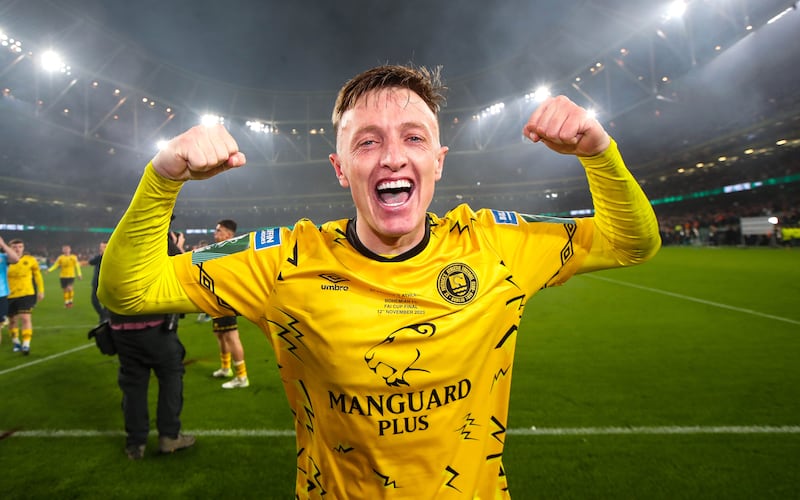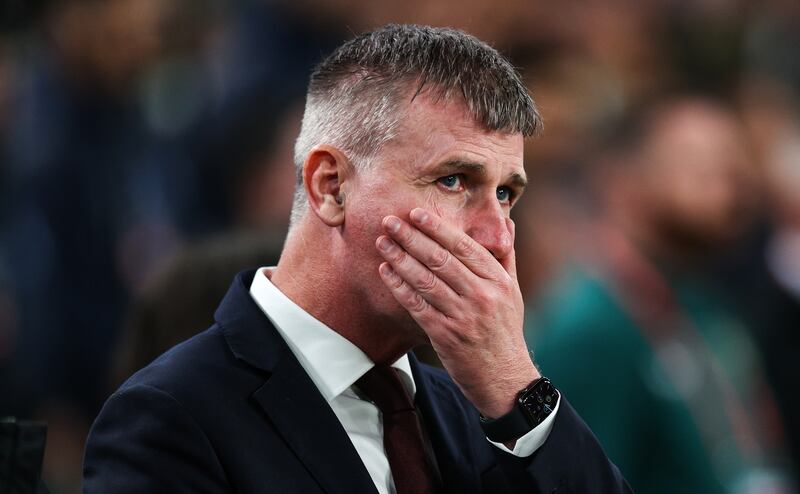The contradiction hit you after crossing Samuel Beckett Bridge and turning left on to Misery Hill. Having just absorbed the morning news regarding another Hill – Jonathan – and yet another story about questionable administration at the FAI, the rising noise and buzz of those in the streets about to form a record attendance at a Lansdowne Road cup final was unmissable.
Here it was: domestic Irish football – a financially-challenged and irregular association at the top; an authentic and growing supporter base eager for clear and structured leadership below.
Upstairs, downstairs some might say.
Hill said on his appointment three years ago this month that he wanted a more “trusted” FAI. He added “respected”.
READ MORE
But if €20,000 was erroneously in his bank account in lieu of holidays and commuting expenses, then both of those aims are in jeopardy, if not over.
In fact, as you walked away from Lansdowne, from the 43,881 present, you thought it was each one of them, as well as the two clubs on show – St Patrick’s Athletic and Bohemians – the players, coaches and the League of Ireland’s volunteerism itself which has rebuilt trust, which is trying to earn respect.
That collective effort was rewarded with a vibrant afternoon, good football and a spectacle that said Irish football must indeed be taking itself seriously. Others are – Manchester United, Everton, Brentford, Luton, Sunderland and Southampton were among the English clubs who had scouts at the final. The contrast with the morning headlines was obvious.
Standing with Chris Forrester outside the boisterous St Pat’s dressingroom, he said the whole event made him “feel like a footballer.” He was beaming and not just from victory.
Given Forrester first played in the League in 2011 – for Bohs – he is in a position to comment on where things are at the end of 2023.
“Sometimes you go to a raggedy old stadium,” he said, a remark that will chime with many League of Ireland fans, if not the administrators; “but the build-up to today, people scrambling for tickets, you can sense it and it’s a good feeling. If someone turns on the TV today and see this, it looks like a spectacle, it looks like a great occasion.
“I think the trajectory is on the rise.”

This was an echo of an opinion Stephen Kenny offered in July 2017 when his Dundalk side had been eliminated narrowly at Rosenborg in a Champions League qualifier.
“It’s tough for us to come to a club like Rosenborg who have 20,000 fans every week,” Kenny said post-match. “There is nothing between the teams and yet we are playing in bloody Oriel Park, very limited facilities, and we are coming to grounds like this.”
Kenny had felt the same a year earlier when Dundalk had drawn 1-1 at Alkmaar in the Europa League group stage. The surroundings had made his players look better and feel better and their performance showed they responded. “Presentation matters,” he said.
Kenny was at Lansdowne last Sunday and will have been chuffed by the presentation, by the youth of so many of the players and more broadly by the redevelopment of Tallaght, the plans for Dalymount, Sligo, Finn Harps and Wexford. There are green shoots.
Scepticism is allowed, though, until there is proof of funds in bank accounts and physical work being undertaken. Should the latest FAI internal ructions affect this, there will be understandable frustration and anger.
Because this feels like a moment of opportunity. It feels like we may review 2023 and see it as a year when things began to change, when Irish women played in a World Cup, when there were big funding plans, young players progressing, Evan Ferguson breaking through and then last Sunday’s record attendance.
As Forrester said: “The message from today, for the FAI and all those involved in the funding is they must be able to see the potential. It’s massive. We all need to capitalise, each club, each organisation, whatever, capitalise on it.
“And do it properly, not just half-arse it.”
Yet history has told Irish football not to get ahead of itself and for all the evidence of progress, there is not a linear pattern. It’s a patchwork quilt of impressions and scenarios and includes an international men’s team that has won three of eight games this calendar year – against Latvia and Gibraltar (twice).
It means that Kenny returns to the Netherlands, to Amsterdam rather than Alkmaar, in a changed role that will soon change again. The many neutrals who wanted him to prosper because of what he had done at home, his conscientious commitment to domestic football, have seen their goodwill fade, particularly in the two matches against Greece.

There was an expectation Ireland should beat Greece. Was that misplaced?
The Greek international team may not be a force, but domestically Olympiakos were in the Champions League group stage three years ago and they are one of three clubs in this season’s Europa League group stage. The Greek league is 15 places above the League of Ireland in Uefa’s coefficient. Olympiakos have a stadium capacity of 33,000, AEK Athens’ is 31,000. Greek football does have its share of turbulence, but it has built its own infrastructure. Greece were champions of Europe in 2004.
Yes, Kenny’s squad came out of Pot 3 in the group draw compared to Greece from Pot 4, but Uefa’s ranking of 26 and 34 showed the difference between the two was not huge. Irish superiority seemed an assumption too far and so it proved. The FAI are not overseeing some dynamic, wealthy infrastructure – Oriel Park is still bloody Oriel Park.
The comparison between Lansdowne last Sunday and last month is another piece of the overall picture. Once chances for Will Smallbone and Ferguson came and went, Greece were comfortable. It is possible to make harsh judgments on such nights and plenty did – about the players’ true abilities and Kenny himself.
It means the focus will soon switch to Lee Carsley. England’s under-21 head coach knows he is on the FAI radar. Carsley, 50 in February, is happy where he is; but he is gettable. It would require a job offer rather than a job interview, but if the association is convinced he is the future, then it appears it is Carsley’s job to take.
He has had success with England’s young players and to return to last Sunday, youthfulness was another aspect of the streets leading to Lansdowne. Young boys and girls saw young players on the pitch.
But then, despite what they were saying upstairs, the League of Ireland never was the problem child.
















